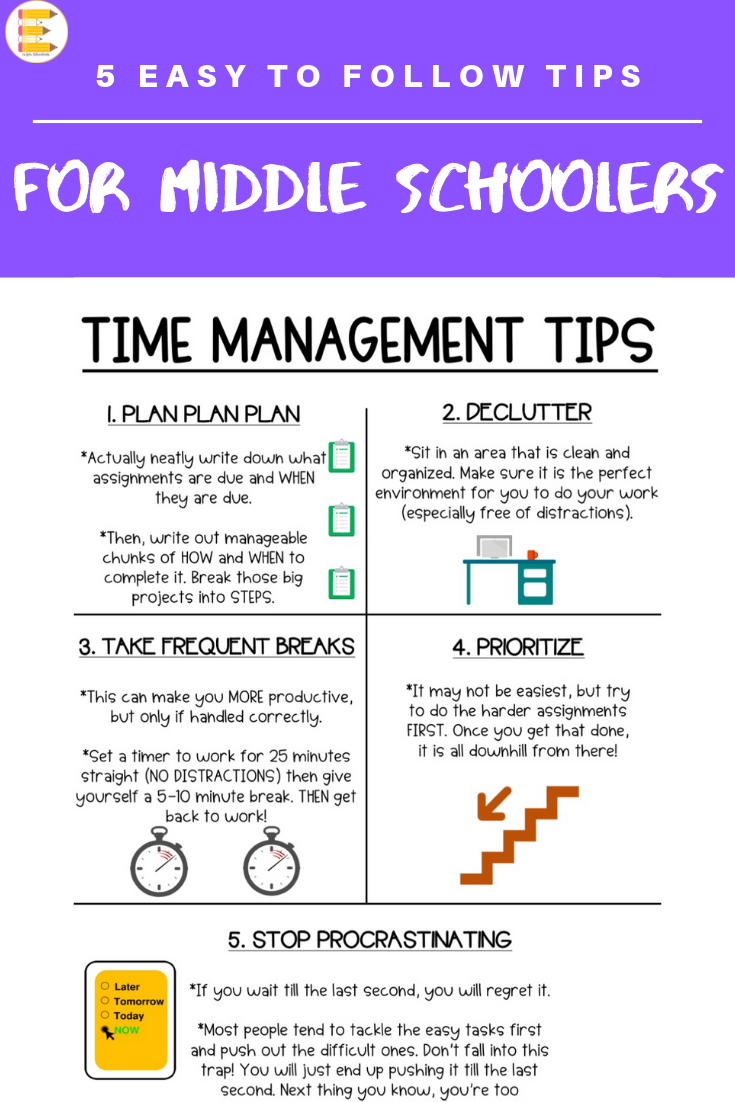Time Management Tips for Middle School Success
Time Management Tips for Middle School Success is critical for navigating the challenges of this developmental stage. Middle school is a period of immense change—new classes, more responsibilities, and the burgeoning social scene all contribute to a complex schedule. Many students struggle to effectively manage their time, leading to stress, poor academic performance, and an overall feeling of being overwhelmed. This article offers practical strategies, backed by insights from educators and successful students, to help middle schoolers master time management and achieve academic and personal success. We’ll cover everything from creating a realistic schedule to prioritizing tasks and maximizing study time, with practical examples and actionable steps.
Understanding the Importance of Time Management
Defining Time Management for Middle Schoolers
Time management in middle school is essentially about planning, organizing, and executing tasks efficiently to balance academic, extracurricular, and social responsibilities. It’s a critical skill that transcends the classroom and prepares students for future success. Time management goes beyond simply managing time; it involves strategically allocating time to specific tasks and prioritizing commitments. This helps students avoid feeling overwhelmed and allows them to accomplish more while avoiding burnout. Effective time management also promotes organization and focus, resulting in higher levels of productivity and accomplishment, even during busy schedules. Strong time management skills equip middle schoolers to navigate these changes effectively, leading to improved academic performance and well-being.
Identifying the Challenges in Middle School
Middle school students face unique challenges when it comes to time management. Increased academic pressure, more demanding extracurricular activities, and the ever-present social life can create a tough balancing act. The pressure to keep up with homework, study for tests, participate in extracurricular activities, and maintain healthy social connections often leads to a feeling of being overwhelmed and a struggle to meet all these obligations. Time constraints often lead to neglecting important tasks, such as studying, or choosing unhealthy shortcuts, like last-minute cramming. This can further increase stress and impede academic performance. Students need tools and techniques to address these challenges proactively.
Creating a Realistic Schedule
Mapping Out Your Weekly Schedule
A detailed weekly schedule is the cornerstone of effective time management. A visual representation helps students see how they can allocate time across their commitments. The schedule should incorporate time for academics, extracurriculars, social activities, and rest. This plan needs to be realistic and flexible, accommodating unexpected events or adjustments as needed. Consider using a planner, a digital calendar, or a whiteboard to create a personalized and visual schedule. By creating a weekly schedule, middle schoolers can visualize their commitments and identify potential conflicts or overlaps, making it easier to adjust and prioritize. This creates a clear roadmap for the week, encouraging a balanced approach to managing commitments.
Prioritizing Tasks and Setting Goals
Prioritizing tasks is equally crucial as creating a schedule. Students need to learn to identify which tasks are most important and time-sensitive and tackle them first. Setting SMART (Specific, Measurable, Achievable, Relevant, Time-bound) goals is helpful for prioritizing. For example, “Study for 30 minutes on math” is a more effective goal than “Study math.” Using a priority system, such as a color-coded system, can visually distinguish urgent from important tasks, aiding the decision-making process in prioritizing tasks.
Maximizing Study Time
Techniques for Effective Studying
Effective studying strategies are crucial for maximizing study time. Active recall, where students test themselves on material, is much more effective than passive rereading. Spaced repetition, reviewing material at increasing intervals, enhances long-term retention. Break down large tasks into smaller, manageable chunks to avoid feeling overwhelmed, which is often an issue when students approach large tasks. Encourage consistent study sessions rather than cramming before a test to improve comprehension and retention. Using a timer can help students stay focused and maintain consistent study periods. By incorporating these strategies, students can become more efficient in using their study time, leading to better outcomes.
Incorporating Breaks and Self-Care
Consistent breaks are just as vital as consistent study sessions. Short breaks throughout the study period can help maintain focus and prevent burnout. These breaks could involve walking around, listening to music, or doing a quick stretch. Self-care is essential to overall well-being and learning. Adequate sleep, healthy meals, and physical activity all play a role in a student’s ability to manage their time effectively. Prioritizing these aspects will ultimately contribute to the student’s ability to focus and learn, improving their time management skills in the long run.
Utilizing Technology and Resources
Digital Tools for Organization
Digital tools and apps can greatly assist with time management. Many planners and calendars offer features to set reminders, track progress, and even create to-do lists. Utilizing apps can also help students in creating and tracking their progress, thus aiding students in staying organized and prioritizing tasks. This will enable middle schoolers to keep track of deadlines and upcoming assignments, ensuring nothing slips through the cracks. For example, apps with task management functions can help to break down complex tasks into smaller, more manageable steps.
Seeking Support from Educators and Peers
Talking to teachers and mentors can be invaluable for managing time effectively. They can offer guidance and strategies to improve time management skills. Middle schoolers can also learn from their peers who have effective time management strategies. Discussing challenges and solutions can help students learn from each other. Consider forming study groups, exchanging time management tips, and supporting each other. This support network creates a collaborative environment and promotes open communication, making the entire process of time management less daunting.
Overcoming Procrastination
Recognizing and Addressing the Root Causes
Understanding the reasons behind procrastination is the first step towards overcoming it. Common causes include fear of failure, difficulty prioritizing tasks, and a lack of organization. Identifying the underlying issue empowers students to develop targeted solutions. For instance, if fear of failure is the root cause, building self-confidence and emphasizing effort over perfection can help mitigate the negative impact of procrastination.
Implementing Strategies to Combat Procrastination
Breaking down large tasks into smaller, manageable steps is crucial. This process allows for a reduction in feeling overwhelmed by the large task itself. Setting realistic deadlines and using timers can further aid in breaking down large tasks into manageable chunks, increasing the probability of completing a task. Also, create a dedicated study space free from distractions, minimizing any external factors, and making the task easier to accomplish. Visualizing the positive results or reward of finishing a task can further motivate students to avoid procrastination.
In conclusion, effective time management is crucial for middle school success. By implementing these strategies, students can balance academics, extracurriculars, and social life effectively. Remember, time management is not about cramming more into your day; it’s about optimizing your schedule to prioritize tasks, study smarter, and reduce stress. Start small, be consistent, and celebrate your progress along the way. For further assistance or support, consider reaching out to a school counselor or a dedicated tutor. You’ve got this!
Share this content:




Post Comment